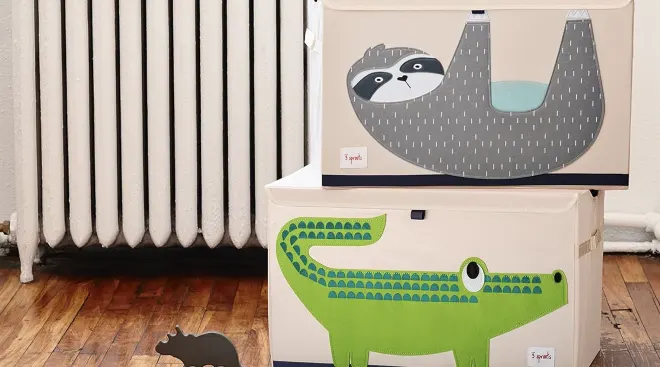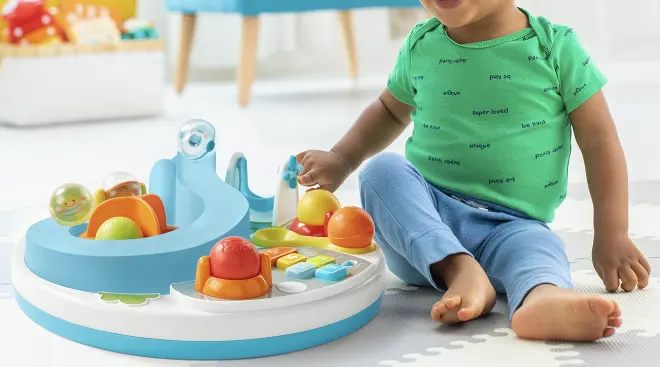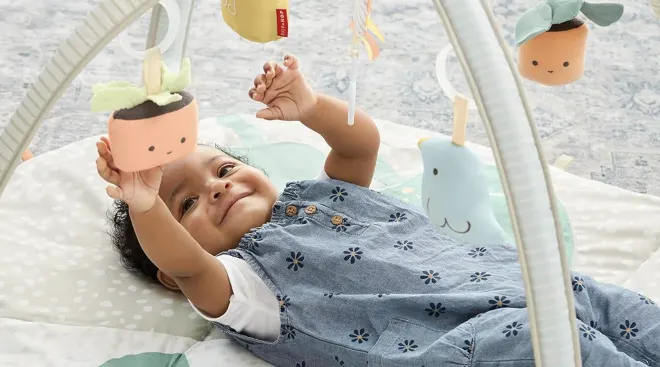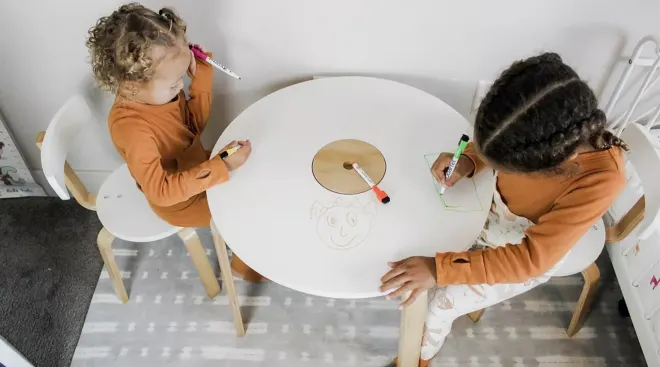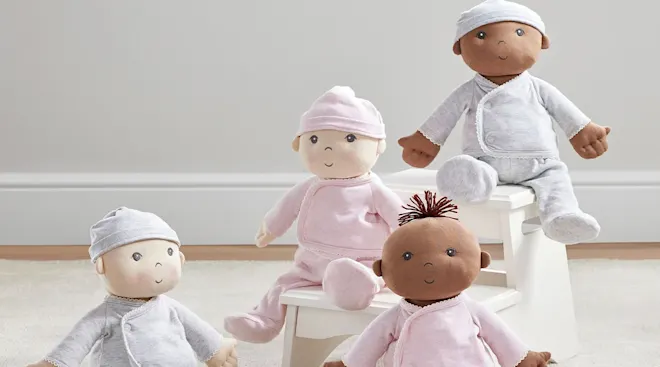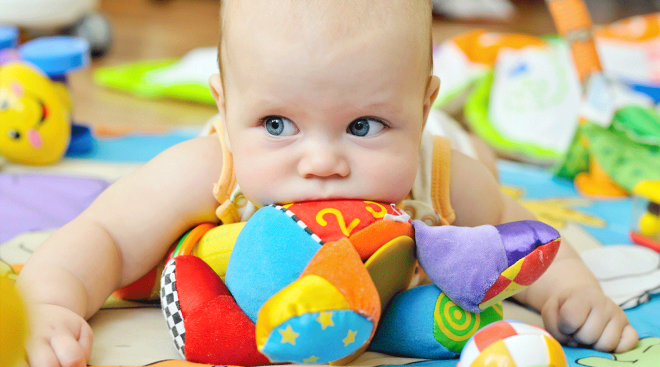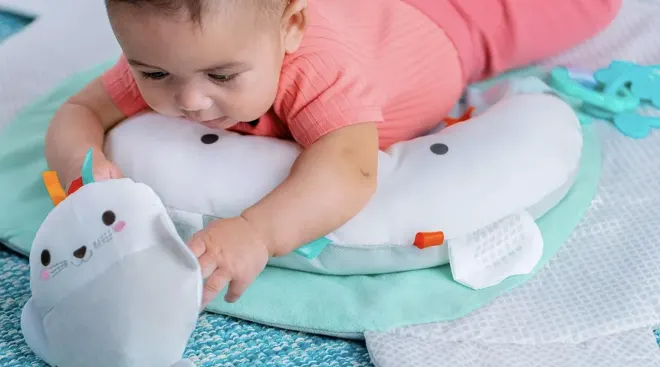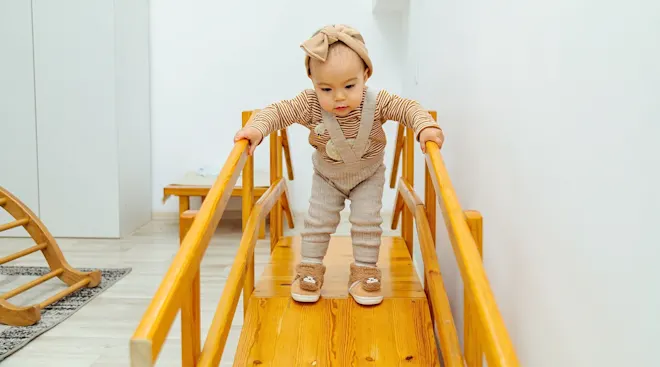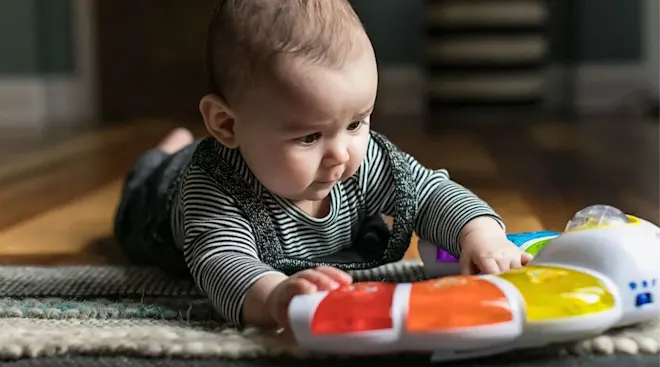The 6 Best Kids’ Sandbox Options to Promote Development
Sandboxes are classic toys for a reason. They offer endless opportunities for imaginative play for infants, toddlers and big kids alike. But they aren’t all fun and games—they also promote development, such as tactical exploration and fine and gross motor skills. “Sand play is very beneficial in development,” says Alexis Phillips-Walker, DO, a pediatrician at Memorial Hermann Medical Group Pediatrics in Atascocita, Texas. “It can help enhance motor skills, social and emotional awareness, assists in the improvement of language and speech as well help with creativity and mathematics and science concepts.”
Ready to treat your little one to some fun in the sun? Below, shop our favorite sandboxes for kids—plus, discover more playtime tips from Phillips-Walker.
To simplify your search for the best kids’ sandbox, we did the bulk of the research, so you don’t have to spend hours scrolling. Here are the steps we took to create this article:
- We interviewed a pediatrician to learn how sandboxes can benefit kids, as well as safety features parents should consider when purchasing and using one at home.
- We researched what was being said about sandboxes in The Bump community forums to learn what parents liked (and didn’t like) about them.
- To understand how these sandboxes have worked for families, we conducted exhaustive market research, scouring external forums and message boards and reading user reviews to find out what parents across the country looked for in a kids’ sandbox.
- Lastly, we considered several aspects when sourcing sandboxes to include in our roundup, including size, weight, age rating, sun protection and material, to name a few.
Editorial integrity is at the heart of everything we publish. Read about how The Bump develops and reviews all articles, including product reviews.
Overall best kids’ sandbox
- Parents love its size
- Comes fully assembled
- Natural aesthetic
- Sand toys included
- Parents say the cover could be more waterproof
Some of the best kids’ sandbox options on the market are those that are made from plastic—just like this one from Step2. The durable design has been made to resemble the look of natural stones, so it won’t be an eyesore in your outdoor space. If your little one and their sibling love to play together, they’ll be able to do so with this sandbox; parents love its size, which isn’t too big or too compact. The sides feature small built-in seats that are ideal for older infants or toddlers—but they may not be the most comfortable for big kids.
The plastic sandbox also comes with a cover, a factor many parents in The Bump community forum consider when choosing one for their family. At the end of the day, simply attach the lid for secure protection from weather and critters overnight. Even better, this option comes with sand toys, like sandcastle molds and a shovel, so you won’t have to worry about purchasing additional accessories. Oh, and did we mention it also comes fully assembled? Score!
Dimensions: 50.4" (L) x 31.3" (W) x 16" (H) | Weight: 14 lbs. | Capacity: 200 lbs. of sand | Age rating: 12 month to 10 years | Material: Plastic
Our community says:
"[My child] loved her sandbox around one year old and still will sit in there for long periods at a time. It is the Step2 Naturally Playful. The lid stays on very well." – curlypie1
Best toddler sandbox
- Built-in water canal
- Cover doubles as a travel bag
- Lightweight
- Affordable price point
- Not suitable for children over 3 years old
- Assembly required
Sand play is a great way to inspire creative thinking and problem-solving in tots. That’s why we’re fans of this smaller sandbox for toddlers. Specifically designed for little ones between 18 to 36 months, it offers a safe, secure spot for your curious kiddo to explore at their own pace. Despite its compact size, it can hold up to 200 lbs. of sand.
However, the best part about this toddler sandbox is its built-in water feature. Surrounding the center is a colorful, grooved canal that can be filled with water for even more sensory-driven fun. For instance, your tot can experiment by mixing sand and liquid or using it to create unique shapes. When playtime is done for the day, use the waterproof cover—which doubles as a tote—to keep unwanted moisture and animals out.
Dimensions: 35.5” (L) x 35.5” (W) x 4.8” (H) | Weight: 6.8 lbs. | Capacity: 200 lbs. of sand | Age rating: 18 to 36 months | Material: Plastic
Best sand table for kids
- Elevated design minimizes messes
- Secure cover
- Natural aesthetic
- Sand toys included
- Relatively low capacity
- Assembly required
Rather than purchasing a sandbox, some parents in The Bump community say they decided to go with a sand table instead. Similar to water tables, these structures offer an elevated area where little ones can play with sand without fully sitting in it. They’re a great option for caregivers who want to minimize messes while still promoting sensory-driven play. That’s why we’re a fan of this sand table for kids from Step2, which even comes with toys.
Parents will appreciate that it comes with a protective lid, which is equipped with plastic tie-downs to ensure it stays in place when not in use. The cover also doubles as another play option, thanks to its molded-in roadways that are perfect for tiny cars and other toy vehicles. Even better, this sandbox for kids been created to resemble natural materials. As a result, it won’t look too out of place on your deck or in your backyard beside your outdoor furniture.
Dimensions: 36” (L) x 26” (W) x 16.4” (H) | Weight: | Capacity: 40 lbs. of sand | Age rating: 3 to 6 years | Material: Plastic
Best wooden sandbox for kids
- Durable, weather-resistant materials
- Parents love how much sand it holds
- Fits multiple kids
- Wide seats
- Assembly required
- Mixed reviews about the cover
- High price point
Next up is a great kids’ sandbox if you’re looking for a wooden option. It’s crafted from solid cedarwood that’s naturally rot- and insect-resistant and known to be super durable in an array of weather conditions. For added peace of mind, this design features eased edges so you can expect it to be free from splinters. At the bottom of this children’s sandbox is a ground liner, allowing for drainage while also suppressing any weeds that may be growing underneath the play area.
While this sandbox for kids does require assembly, parents say it’s straightforward to build. All you’ll need is a standard Phillips screwdriver to securely connect the precut notches. When finished, you’ll have a spacious sandbox complete with wide, comfortable seatboards that the whole family can enjoy. The sustainable design also comes with an eco-friendly cover, so you can keep it protected at night and during cooler weather. Parents of multiple kiddos will also appreciate that it’s suitable for little ones from 3 to 10 years, so you can count on it as a playtime staple for many seasons to come.
Dimensions: 75”(L) x 72” (W) x 9” (H) | Weight: 28 lbs. | Capacity: 800 lbs. of sand | Age rating: 3 to 10 years | Material: Cedarwood
Best small sandbox for kids
- Can be used inside or out
- Double as toy storage
- Playful caterpillar design
- Small design may not suit older kids
- Assembly required
If you have a small outdoor space or simply want to keep outdoor toys to a minimum, a small sandbox for kids could be the best option for your family—and this caterpillar-shaped design checks all of the boxes on our list. The compact covered sandbox can be used inside or out, depending on your preferences. And, of course, your little one is sure to adore the playful silhouette.
Wherever you place this sandbox for toddlers and kids, you’ll appreciate its narrow footprint. Plus, thanks to its elongated shape, it’s easy for several kiddos to kneel around it and play together. When not filled with sand, the versatile design can be used as a unique toy storage solution, adding to its versatility. Last but not least, minimal assembly is required, so you won’t have to dedicate hours to constructing it.
Dimensions: 44” (L) x 20” (W) x 14.3” (H) | Weight: 15 lbs. | Capacity: 150 lbs. of sand | Age rating: 12 months to 8 years | Material: Plastic
Best kids’ sandbox with canopy
- Offers sun protection
- Built-in storage
- Wide sides double as seating
- Fits multiple kids
- Large footprint
- Doesn’t come with a cover
- Assembly required
- High price point
When picking out a kids’ sandbox, many parents consider sun protection, especially if they don’t have a lot of shaded space in their outdoor area. If this is an important factor to you, opt for a play structure that comes with a canopy or umbrella, just like this option from KidKraft. Resembling a beach cabana, this impressive kids’ sandbox comes with a navy-and-white striped canopy to keep little ones protected from the sun. As they play, they can choose to sit outside of the structure, directly in the sand or use the wide edges as a seat. Plastic bins are featured on one side, giving children a separate space to experiment with water or to store their favorite sand toys.
Equal parts stylish and functional, this sandbox is made from honey-colored Sanmu wood that has been reinforced to prevent warping. As a result, you can expect the play structure to endure various weather conditions. Moreover, it’s equipped with a plastic liner on the bottom to keep sand in place while allowing for drainage when needed. One thing to note: While this sandbox has a built-in canopy, it doesn’t come with a cover, so you will probably need to purchase one separately to keep it protected when not in use.
Dimensions: 64.3” (L) x 60.2” (W) x 51” (H) | Weight: 52.8 lbs. | Capacity: 750 lbs. of sand | Age rating: 2 to 8 years | Material: Wood
Kids' Sandbox Comparison Chart
| Overall best kids’ sandbox | Best toddler sandbox | Best sand table for kids | Best wooden sandbox for kids | Best small sandbox for kids | Best kids’ sandbox with canopy | |
|---|---|---|---|---|---|---|
Overall Best  Step2 Naturally Playful Sandbox II |  Grow'n Up Portable Sand Box |  Step2 Naturally Playful Sand Table |  Creative Cedar Designs Octagon Wooden Cedar Sandbox |  Simplay3 Caterpillar Sandbox | 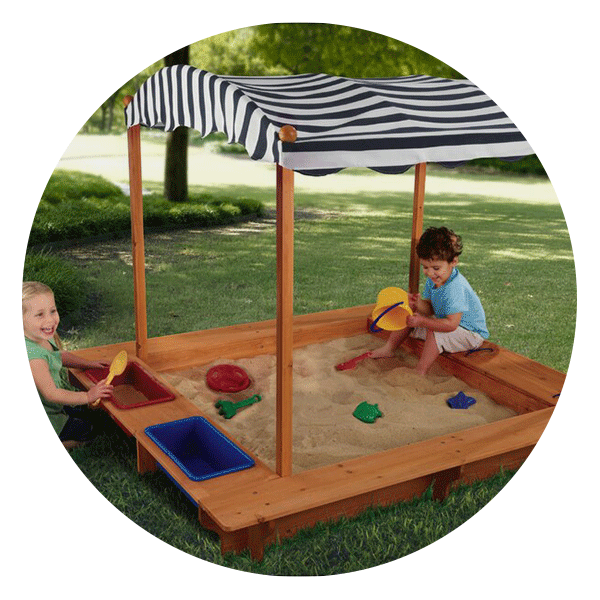 KidKraft Outdoor Sandbox with Canopy | |
| Price | $$ | $ | $$ | $$$ | $$ | $$$ |
| Dimensions | 50.4" (L) x 31.3" (W) x 16" (H) | 35.5” (L) x 35.5” (W) x 4.8” (H) | 36” (L) x 26” (W) x 16.4” (H) | 75”(L) x 72” (W) x 9” (H) | 44” (L) x 20” (W) x 14.3” (H) | 64.3” (L) x 60.2” (W) x 51” (H) |
| Cover | ||||||
| Sun protection | ||||||
| Age rating | 12 months to 10 years | 18 to 36 months | 3 to 6 years | 3 to 10 years | 12 months to 8 years | 2 to 8 years |
| Buy NowRead Full Review | Buy NowRead Full Review | Buy NowRead Full Review | Buy NowRead Full Review | Buy NowRead Full Review | Buy NowRead Full Review |
Kids’ sandboxes nurture motor skill enhancement, social and emotional awareness and language development. Another advantage? Sand play can also nurture creativity and problem-solving while introducing STEM concepts to little learners, adds Phillips-Walker. The unique consistency and texture of sand invites children to explore their surroundings with their senses. What’s more, sand can be played with in so many different ways, making it a versatile addition to any backyard. While sandboxes can lead to inevitable messes at times, most parents in The Bump community forum say they’re worth it. Here, read about why parents from our community love their kids’ sandboxes:
"My [child] loves her sandbox. She will easily pay in it for 45 minutes at a crack. She is always asking to go out and play in her sandbox." – Hopin4aBaby
"We just got a sandbox, and both boys will play with it for hours. Yesterday we were out there for 2.5 hours and only came in because it was starting to rain." – jsugrin
"[My child] will play in it for 30 minutes at a time. When he throws the sand, it goes under the tree, so the mess isn't bad. I usually take his shoes off so they don't get sand all in them and his clothes brush right off." – murphyec
While playing with sand offers plenty of advantages, there are also some safety considerations to keep in mind. Phillips-Walker advises parents to only buy river or beach sand, and to avoid products made from crushed limestone, marble, crystalline silica or any other dusty material. Another tip? Ensure wet sand dries thoroughly before covering a sandbox so bacteria doesn’t form. To prevent potential scrapes and splinters, sandboxes need to be regularly maintained. Phillips-Walker also recommends that parents opt for designs made from nontoxic wood or plastic. What’s more, four-legged family members shouldn’t play in the sandbox with your kiddo. Why? They may go to the bathroom in it, says Phillips-Walker, which would definitely put a damper on outdoor fun.
When it comes to placing your kids’ sandbox, be sure it’s on stable ground, whether that be in your garden or on a patio. Apart from that, where you set it up is largely down to personal preference. “We have ours in the yard, near [our child’s] swingset and playhouse. I figured the sandbox would get used for a few years so I wasn’t too worried about it. I can always re-seed the area when we do get rid of it,” comments Sept17.05Bride, a parent from The Bump community forums. Alternatively, April35, another parent from our forums, says: “We keep ours on our deck. If [our child] makes a mess, I just sweep the sand between the deck boards and it falls through to under the deck.”
Sandboxes come in all shapes, styles and sizes, which can make it tough to narrow down your options. To find the perfect match for your family, consider the following features as you shop:
- Sun protection. Your child’s delicate skin is extra sensitive to the sun. In addition to applying sunscreen regularly, opt for a sandbox with a canopy, or place it in a shaded area.
- Coverage. Since sandboxes stay outside, they need to be able to withstand various weather conditions. Phillips-Walker suggests choosing one with a lid to keep sand dry and keep any critters out. “We also have [a sandbox] with a cover; I think that’s pretty much a must. I don’t think it’s a [pain] at all, I just make sure we cover it as soon as we’re done playing,” says mlf625, a parent from The Bump community forums.
- Durability. Whether you have your eye on a plastic or wooden sandbox, you’ll want to make sure it’s durable. Choose high-quality materials and sturdy designs to ensure you can count on it for years to come, no matter the weather. For instance, SummerBabyLove,](https://forums.thebump.com/discussion/12466529/sandbox-during-winter),) a parent from The Bump community forums, commented: “I live in New England… [our sandbox is] left outside year-round and has not had any issues with the plastic cracking.”
- Size. Before purchasing a sandbox, consider the size of your backyard and how many kids will be using it. If you have multiple little ones, a large option would be best. Conversely, if only one child will be playing in it, go for a design better suited for solo play.
- Accessories. Some sandboxes for toddlers and kids even come with sand toys and other fun accessories. This way, you won’t have to worry about purchasing separate playthings.
About the writer:
Emma O’Regan-Reidy is an editor at The Bump. She specializes in writing e-commerce content about the latest and greatest in pregnancy, postpartum and parenting. O’Regan-Reidy has researched an array of topics, from prenatal vitamins and postpartum pads to the best non-wifi baby monitors, toddler learning towers and everything in between. With over a four-year career in digital media, O’Regan-Reidy aims to create engaging, helpful articles that inform new and seasoned parents.
Plus, more from The Bump:
Alexis Phillips-Walker, DO, is a pediatrician at Memorial Hermann Medical Group Pediatrics in Atascocita, Texas. She earned her medical degree from Ohio University College of Osteopathic Medicine in Athens.
Learn how we keep our content accurate and up-to-date by reading our medical review and editorial process.
Navigate forward to interact with the calendar and select a date. Press the question mark key to get the keyboard shortcuts for changing dates.






































